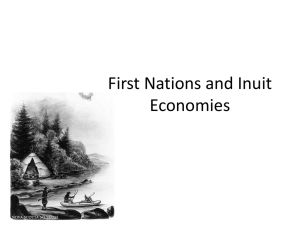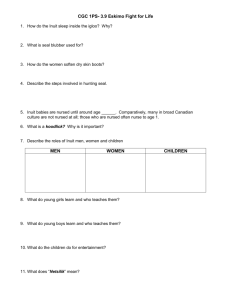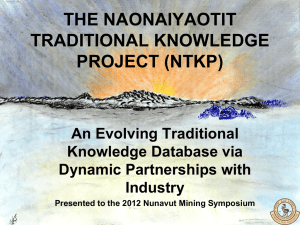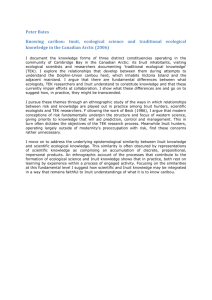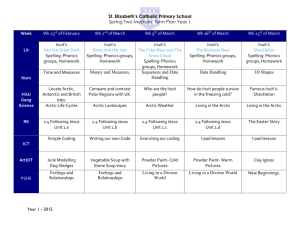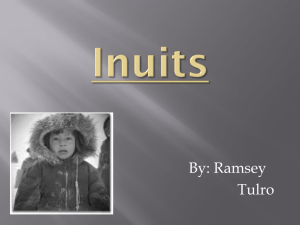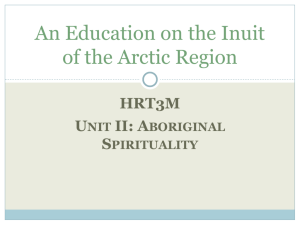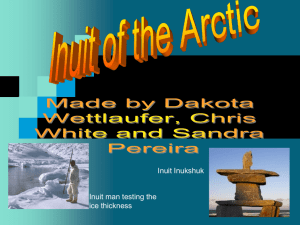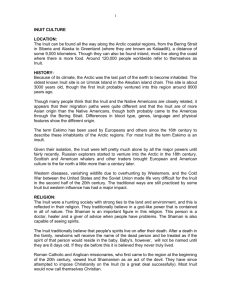Inuit Poetry.doc - Adult Basic Education Integration Wiki
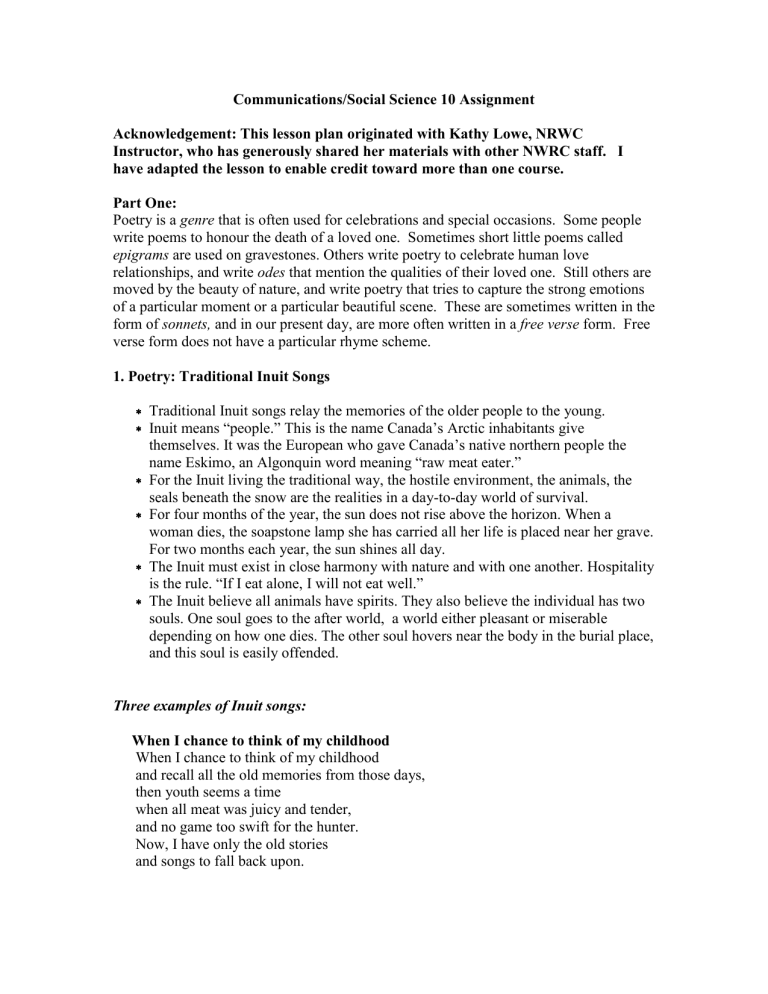
Communications/Social Science 10 Assignment
Acknowledgement: This lesson plan originated with Kathy Lowe, NRWC
Instructor, who has generously shared her materials with other NWRC staff. I have adapted the lesson to enable credit toward more than one course.
Part One:
Poetry is a genre that is often used for celebrations and special occasions. Some people write poems to honour the death of a loved one. Sometimes short little poems called epigrams are used on gravestones. Others write poetry to celebrate human love relationships, and write odes that mention the qualities of their loved one. Still others are moved by the beauty of nature, and write poetry that tries to capture the strong emotions of a particular moment or a particular beautiful scene. These are sometimes written in the form of sonnets, and in our present day, are more often written in a free verse form. Free verse form does not have a particular rhyme scheme.
1. Poetry: Traditional Inuit Songs
Traditional Inuit songs relay the memories of the older people to the young.
Inuit means “people.” This is the name Canada’s Arctic inhabitants give themselves. It was the European who gave Canada’s native northern people the name Eskimo, an Algonquin word meaning “raw meat eater.”
For the Inuit living the traditional way, the hostile environment, the animals, the seals beneath the snow are the realities in a day-to-day world of survival.
For four months of the year, the sun does not rise above the horizon. When a woman dies, the soapstone lamp she has carried all her life is placed near her grave.
For two months each year, the sun shines all day.
The Inuit must exist in close harmony with nature and with one another. Hospitality is the rule. “If I eat alone, I will not eat well.”
The Inuit believe all animals have spirits. They also believe the individual has two souls. One soul goes to the after world, a world either pleasant or miserable depending on how one dies. The other soul hovers near the body in the burial place, and this soul is easily offended.
Three examples of Inuit songs:
When I chance to think of my childhood
When I chance to think of my childhood and recall all the old memories from those days, then youth seems a time when all meat was juicy and tender, and no game too swift for the hunter.
Now, I have only the old stories and songs to fall back upon.
I will walk with leg muscles
I will walk with leg muscles which are strong as the sinews of the shins of the little caribou calf
I will walk with leg muscles which are strong as the sinews of the little hare.
I will take care not to go toward the dark.
I will go towards the day.
The Great Sea
The great sea has sent me adrift, it moves me as the weed in the great river, earth and the great weather move me, have carried me away and move my inward parts with joy.
-Uvavnuk
These poems are examples of lyric poetry which is considered the most popular form of poetry. Lyric poetry is often short and emotional, expressing direct statement of the poet’s deepest feeling. It grows out of his or her conviction that an experience, whether beautiful or painful, is worth expressing.
These poets felt their experience sharply. They are acutely aware of the world they live in: the beauty of a summer’s day, the love of a person, the angers, the sorrows and the pleasures of everyday life. Their art lies in their ability to translate these experiences into words, to experiment with sounds and rhythms of language which are apparent in these poems.
Exercise: Divide into groups of 4 and do the following questions/activities as a team effort.
1. For each poem, write one sentence that states what you think the person who is writing the poem is trying to celebrate. (6 marks – 1 for the answer, and 1 for a complete sentence)
2. For each poem, use one word to describe the emotion that the writer is feeling. As a group, you will need to reach a consensus . (3 marks)
3. Choose two of the above poems and describe the pictures (visual image you see in your mind) when you read them. (Use complete sentences – 6 marks)
Part Two:
1.
Group Project:
With your group, do a short project on Inuit culture. Represent your findings using text, objects, and pictures. Use one-half of a bristol board sheet, and be prepared to report back to the class on your findings. The following topics are your guide: foods, clothing, beliefs (values), geographic location. After 30 minutes on the internet, gather your findings and spend 20-30 minutes on putting together a presentation on the bristol board. As a group, decide how you are going to report your information back to the class, using the collage as your resource.
Use the following websites to research the information. Due to the 30 minute time frame, you might want to assign one person to each website to gather information about all 4 topics, or assign one topic per person, using one or more of the 4 websites. http://www.windows.ucar.edu/tour/link=/earth/polar/inuit_culture.html
http://www.virtualmuseum.ca/English/Teacher/inuit_history.html
http://epe.lac-bac.gc.ca/100/205/301/ic/cdc/arctic/inuit/people.htm
http://www.itk.ca/5000-year-heritage/regions.php
2. Individual activity:
After you have completed your group work, do the following activity:
(10 marks)
Write a poem in the traditional Inuit style. Choose a simple topic, use simple words and sentences. Think of a world where the basic elements of shelter, food, light, travel, warmth and friendship have first claim to your attention.
OR
Choose one of the Inuit stories/legends from the websites you visited. Write a brief summary of what the story is about. Include:
the title of the story
the setting of the story
the main message (theme) of the story
the main character(s) of the story
the main event(s) within the story
Make sure to double-space and use paragraph form.
